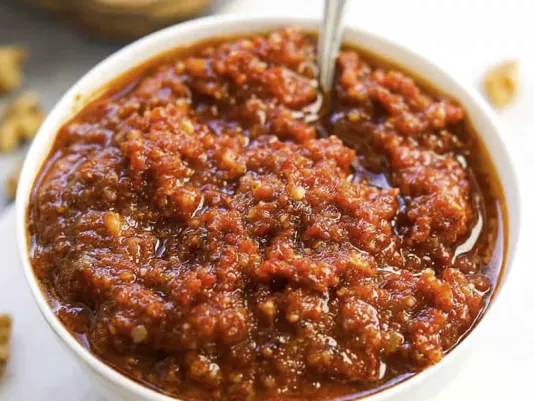Focaccia and Tomato Gratin
Focaccia and tomato gratin is an Italian recipe, if you don't stock up on focaccia, you can use white bread.

Red pesto is one of those products I consider essential in modern cooking. Its strength lies in combining the sincerity of homemade taste with professional depth. Over the years, I’ve learned to appreciate this ingredient for its consistency: it doesn’t run, lose its aroma, and adapts perfectly to different types of dishes. When I think about balance on a plate, red pesto is always the first thing that comes to mind. It brings other components together, creating a complete flavor. Its real value lies in simplicity: it’s a concentrated expression of ripe tomatoes, good cheese, nuts, and fresh greens. And every time I open a jar, I feel the same confidence that the dish needs nothing more.
I always start with the color: it should be warm, red-terracotta, without dull spots or excessive oil sheen. If the surface of the sauce is too shiny or separates into a layer of fat, it means the product is old or was stored improperly. Real pesto has a uniform texture – finely chopped pieces of tomatoes, nuts, and cheese without lumps or grit. The aroma is clean and fresh, with notes of basil, cheese, and a light tanginess. I always check the ingredients: only sun-dried tomatoes, hard cheese, nuts, basil, olive oil, salt, and a touch of garlic. Any additives, starch, or preservatives signal that the manufacturer cut corners. Over the years, I’ve noticed that the best pesto is sold in glass jars – plastic affects the aroma. Whenever possible, I choose products from Italy or Spain, though local producers have also learned to make good quality pesto when using natural ingredients. The main thing is to avoid overly cheap options: they usually taste bitter or have a vinegary aftertaste that lingers even in the finished dish.
When I work with pesto, it’s important to preserve its natural structure. If the sauce has been refrigerated, let it sit for a few minutes at room temperature – the cold makes it firm and mutes its aroma. I don’t recommend heating pesto directly: high temperatures make the cheese curdle and the oil turn bitter. If the pesto is too thick, I add a few drops of warm olive oil to restore its elasticity. Before using, it’s best to stir it with a wooden spoon to recombine all components. Over the years, I’ve noticed that good-quality pesto has a subtle shine but not an oily surface. If you see separation, it’s not always bad – just stir it gently. Once prepared, the sauce becomes aromatic and uniform, ready for any use – from a main dish to a side or appetizer.
Red pesto is highly sensitive to temperature. Excessive heat destroys natural oils and basil aroma, while cold reduces flavor intensity. I always add it at the end of cooking – into a warm, not hot dish. This helps preserve its aroma and color. If used in baking, remember that it darkens during baking, so don’t spread it on top. In sauces, it remains stable and doesn’t separate, even when in contact with hot foods, if it’s first diluted with a spoonful of warm water or broth. From years of practice, I’ve learned that the more consistent the temperature when serving, the purer the flavor. Too hot a dish can release oil from the pesto, while cold dulls its aroma. The ideal serving condition is warm but not hot – the perfect balance for maintaining color and texture.
I consider this ingredient one of the most versatile in modern cuisine. Its main flavor is a deep tomato sweetness with gentle nutty warmth. With white meat, pesto becomes delicate; with red meat, it enhances juiciness. With vegetables, it creates a natural contrast, especially with eggplant, peppers, or zucchini. I love using it as a base element in cold dishes: even a small amount adds structure and fullness without extra salt. It pairs well with grains like bulgur, quinoa, and couscous, giving them a warm, rich tone. With cheese, pesto behaves subtly, highlighting creaminess without overpowering the flavor. In my experience, it often replaces several spices at once, as it naturally balances acidity, salt, and fat. Its aroma can be described as sunny, warm, yet unobtrusive – the very reason chefs who value pure, unexaggerated taste love it so much.
Even the best product loses its qualities if stored improperly. After opening a jar, I always smooth the surface of the sauce and cover it with a thin layer of olive oil – this creates a natural barrier against air. I store it only in glass, in the refrigerator at a stable temperature. If the pesto starts to darken or develops a faint sour smell, it should be discarded. On average, its shelf life after opening is 5-7 days, but it tastes best in the first three. For longer storage, I portion it into small containers and freeze it. After thawing, the texture becomes slightly softer, but the aroma remains intact. Never use metal spoons – they oxidize the sauce and alter its flavor. In my experience, if stored correctly, pesto’s color and scent remain stable until the last spoonful. This is one of those cases where attention to detail directly affects the quality of the final dish.